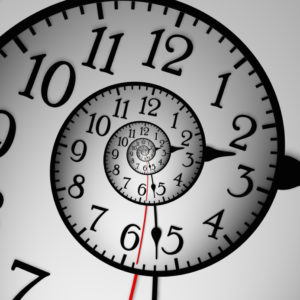 Time moves slowly when sitting on a very hot surface and when waiting for a lover to arrive. It moves quickly when joyful. If life is threatened time moves very slowly. The sense of time passing is strongly related to feelings, which are critical for decisions and actions. The brain mechanisms are not clear. But, there are many current research approaches to the relation of feelings and the sense of time in the brain.
Time moves slowly when sitting on a very hot surface and when waiting for a lover to arrive. It moves quickly when joyful. If life is threatened time moves very slowly. The sense of time passing is strongly related to feelings, which are critical for decisions and actions. The brain mechanisms are not clear. But, there are many current research approaches to the relation of feelings and the sense of time in the brain.
Perception of Time
Human perception of time is extremely broad — milliseconds to decades. The brain can be a very accurate alarm clock. Psychoactive medications and substances, including psychedelics, alter the sense of time, as does religious experience (see post). Some illnesses, such as Parkinson’s, alter perception of time and rhythm. A previous post described effective therapies for Parkinson’s disorder using rhythmic movement and music.
 It has been said that the sense of time’s passage is faster in the elderly, (whose day is 1/20,000 of their life) and slower in the young (each day a much smaller percentage of their life). While some studies show a difference in time perception between elderly and children, this is not yet certain.
It has been said that the sense of time’s passage is faster in the elderly, (whose day is 1/20,000 of their life) and slower in the young (each day a much smaller percentage of their life). While some studies show a difference in time perception between elderly and children, this is not yet certain.
When a threat occurs, emotional attention increases in limbic regions, such as the amygdala, increasing the detail of observed material. One explanation of the slowing of time in a crisis is that the brain is reviewing many more details per second than we normally do. In childhood there might be more details in each moment which might create the sense of slowed time.
One time related illusion, among many, involves observation of movement after a saccade (the quick eye movements occurring constantly that are the quanta of our visual perception). The stuck clock illusion involves suddenly turning visual attention to an old fashioned clock with a second hand; the second hand doesn’t appear to move at first or moves very slowly.
What is Time?
Newtonian time is part of the universe where things happen in a sequence in a three dimensional space – a container that we move through. Another view is a mental structure, like number and space, where humans compare events. In this view it is not measurable. To some, time has a direction with the definite past, indefinite future, and the inexactly defined “present.”
 Einstein re conceptualized time as relative to the speed of light. His view of simultaneous events requires a speeding-up and slowing of time based upon the observation vantage point. A mathematical structure combines three space dimensions and the dimension of time. Distance is only measured in light time.
Einstein re conceptualized time as relative to the speed of light. His view of simultaneous events requires a speeding-up and slowing of time based upon the observation vantage point. A mathematical structure combines three space dimensions and the dimension of time. Distance is only measured in light time.
Circadian Clock
To determine where time resides in the brain, one obvious place to look is the circadian mechanism, which reflects timing of sunlight and darkness cycles in organisms.
As well as the circadian clock in the suprachiasmic nucleus of the hypothalamus, time related to movement is regulated in the cerebellum in the range of seconds and minutes. Other brain regions processing time sense are distributed in the cortex, cerebellum, and striatum. fMRI shows that lesions of many of the brain regions produce inabilities to use time–cerebellum (habit motor memory), striatum (coordinated movement), frontal cortex (decision making) and insula (integration of emotion, cognition and body maps).
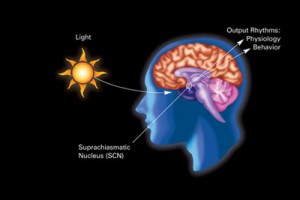 The known mechanisms of the circadian clock involve proteins and DNA modulated in feedback loops. Part of this process is in the cytoplasm and then moves to the nucleus stimulating many genes, some called “period” genes, PER1, PER2, PER3 and other blue light receptor genes, crytochrome genes CRY1 and CRY2.
The known mechanisms of the circadian clock involve proteins and DNA modulated in feedback loops. Part of this process is in the cytoplasm and then moves to the nucleus stimulating many genes, some called “period” genes, PER1, PER2, PER3 and other blue light receptor genes, crytochrome genes CRY1 and CRY2.
The feedback loops are both positive and negative and create an oscillation of 24 hours that measures time in the cycle of day and night. The process is very complex and possibly regulated by ubiquitination, histone modification with HDAC and phosphorylation.
The molecular scillations have also been observed in all animals and bacteria. One important bacterial oscillation occurs in processes of photosynthesis and nitrogen fixation in cyanobacteria. (see post on microbe oscillations).
Unfortunately, it is not known how the 24 clock relates to a decade long clock or a 4 second clock.
Microbes and Human Circadian Rhythms
 Bacteria are noted to have circadian clocks of various durations. These microbe clocks, like many other microbe properties, might be crucial for their hosts. One study recently identified microbes in the squid that provide the squid’s clock. The bacteria which light up at night to guide the squid, increase squid gene activity for light responsiveness in the compartment where the bacteria live.
Bacteria are noted to have circadian clocks of various durations. These microbe clocks, like many other microbe properties, might be crucial for their hosts. One study recently identified microbes in the squid that provide the squid’s clock. The bacteria which light up at night to guide the squid, increase squid gene activity for light responsiveness in the compartment where the bacteria live.
In human beings the immune system is highly connected to the clock. Also many microbes in the gut have clocks that affect peristalsis (intestinal functional movement). Obesity and diabetes are tied into gut based microbes and clocks in microbes and lining cells.
Since microbes in the human gut have 100x the DNA of the human being, the vast utilization of these microbe genes is just being researched.
Human Perception of Time
Much like other aspects of subjective human experience, there is no unifying brain region or module, but rather many different potential clocks.
There are a wide range of suggestions about how different clocks might operate. One view is that that increased neuronal activity peaks at the end of a specific timed duration. Another theory is that there are specific brain structures that measure time, just as there are specific grid cells to measure living space and specific brain maps to measure internal spaces and functions. The oldest theory is of a pulsing pacemaker like a ticking clock. A fourth theory is that the amount of emotion, energy and motivation involved in behavior determine the sense of duration. A fifth view is that as sensory information is accumulated, neuroplasticity changes in the circuits determine a sense of duration of time by the accumulated events. In this view, each different circuit with neuroplasticity can determine a sense of duration of time.
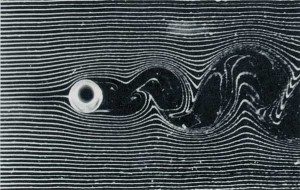 An important model of time is based upon the flow of energy in brain circuits, similar to the passing of water in a stream. It compares a steady energy flow to the flow of particular activities, which is how feelings may affect the perception of time.
An important model of time is based upon the flow of energy in brain circuits, similar to the passing of water in a stream. It compares a steady energy flow to the flow of particular activities, which is how feelings may affect the perception of time.
There are other possible mechanisms, such as brain wave oscillations of specific frequencies and in specific circuits– possibly in the parietal regions where space and number are represented, or the dorsolateral pre frontal cortex (dlPFC), or as part of habit memory in the cerebellum. The insula was described in the previous post on feelings and brain maps as a central place where body maps, emotion and cognition intersect, and could create timed sequences.
Multi Modal Time Sense
 Attention affects the sense of the duration of time, such as the time a basketball player has to shoot the ball before the shot clock runs out. Both athletes and spectators are intensely aware of this passage of time, perceiving it increasingly slowly the more critical it becomes, the last fraction of a second being the slowest.
Attention affects the sense of the duration of time, such as the time a basketball player has to shoot the ball before the shot clock runs out. Both athletes and spectators are intensely aware of this passage of time, perceiving it increasingly slowly the more critical it becomes, the last fraction of a second being the slowest.
The accuracy of our time perception is quite remarkable being able to combine light, sound, smell, and touch information all traveling to us at vastly different rates, and all registering in the circuits at different rates. In fact, the concept of “now” would be different if based only on the speed and timing of one of these sources of information.
The brain combines all of these signals to produce one moment. It processes sound faster than light even though light is so much faster in arriving than sound. Touch is slowest to register in the brain circuits.
Like many important brain processes, it appears that the entire brain is utilized. For more on the importance of widely distributed brain circuits in neuroplasticity, learning and memory see post on neuroplasticity occurring in brain circuits, not just single synapses.
Short and Long Timescales
As life exists simultaneously in 8 orders of magnitude of size, a similarly huge range of orders of magnitude exists in time scales utilized by the brain (see post on Mind and Orders of Magnitude).
Flow model research is able to correlate neural activity up to 300 milliseconds. The model doesn’t work for mental activity in the range of seconds and longer. Flow research showed distinction of two events separated by 50 to 100 milliseconds was not accurate, but those from 200 milliseconds to a second were much more accurate. The millisecond measures of time were able to be correlated with specific circuit activity, but longer intervals involved with planning and thinking appears to utilize other mechanisms.
Activity of approximately three seconds appears to be one mechanism.
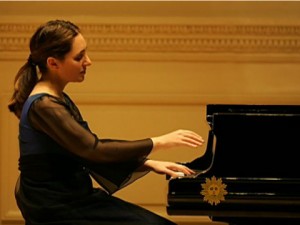 When anyone listens to a metronome with a regular beat, the brain will automatically perceive the beat in a rhythm where certain time durations are emphasized, such as hearing it as a waltz. Usually this involves a rhythm in the range of three seconds or less. Pianists who are holding a finger more than the three seconds in between a stroke actually move the finger slightly in an interval near three seconds. With fMRI, the brain’s motor system was much more active when intervals of two seconds were used.
When anyone listens to a metronome with a regular beat, the brain will automatically perceive the beat in a rhythm where certain time durations are emphasized, such as hearing it as a waltz. Usually this involves a rhythm in the range of three seconds or less. Pianists who are holding a finger more than the three seconds in between a stroke actually move the finger slightly in an interval near three seconds. With fMRI, the brain’s motor system was much more active when intervals of two seconds were used.
Another approach used fMRI to look at which regions of the brain are activated by longer intervals. This approach showed activity in the motor system and the frontal lobe, correlated with evaluation and complex decision-making. These same regions showed similar longer duration responses with another research approach measuring secretion of neurotransmitters.
Feelings, Time and Body States
While studies validate that strong feelings make the subjective experience of time appear longer, individual differences occur based on past personal experience and different stimuli. The subjective time difference is influenced by internal body states.
 The subjective increase of time from strong emotion was greatest when the subject’s faces mirrored the emotion being observed in the research stimulus–a strong connection to the body. When these facial experiences were blocked (holding a pen in the mouth), the subjective experience was not increased.
The subjective increase of time from strong emotion was greatest when the subject’s faces mirrored the emotion being observed in the research stimulus–a strong connection to the body. When these facial experiences were blocked (holding a pen in the mouth), the subjective experience was not increased.
Also physical pain and body temperature changes correlated with increased subjective time. Those excited by exposure to a phobic stimulus, such as a live spider, or waiting for an electric shock, also experienced increased subjective time.
Peaks of additive neural activity appear to be related to subjective experience of duration. The same peaks occurred with both waiting and with action, with stimulation from internal states or external cues. Animal studies showed that activity peaks with durations of 2 seconds, 4 seconds, and 8 seconds each involved different neural circuits. At this time it is not possible to perform these experiments in humans.
Insula, Time and Body Maps
The insula, described in the previous post as the major intersection of cognition, feelings, and body maps, does appear to be associated with the experience of a “moment.” The insula appears to put together a stream of moments, combining body states, feelings and cognitive processes including autobiographical memory.
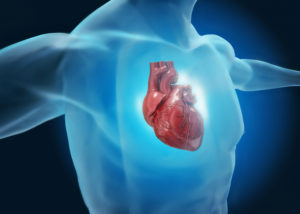 Neural activity peaks in the insula correlated with timed activity tasks of 10 seconds. These neural peaks appeared to be activity from lower brain regions accumulating in the insula.
Neural activity peaks in the insula correlated with timed activity tasks of 10 seconds. These neural peaks appeared to be activity from lower brain regions accumulating in the insula.
Importantly, studies showed a correlation of the heart rate, a major internal state, and the subjective experience of time. Those who are more aware of their own heartbeat were able to more accurately determine real time compared with subjective time sense. Knowing the heart rate appears to anchor the real time.
Thus, it is possible that the internal body states using body maps produce both feelings and the neural activity that affects time experience. In general, research shows that those who are more aware of their own internal states are more able to accurately sense time intervals.
A Sense of Control and Subjective Time
Subjective time and a sense of control has been addressed in a recent study. As before, very disturbing negative experiences were associated with a slowing of time, and very positive experiences with quickening. Spider phobics had the slowest sense of time when seeing the spider. Uniquely, this study included experiences that are fairly neutral, commonplace or boring; it also included very slightly positive experiences and slightly negative experiences. Strangely, the slightly positive experiences lasted longer as apposed to intensely positive which were much shorter.
Subjects in the experiment had the illusion they controlled the length of time of the disturbing or positive images (pressing buttons), but in fact, the buttons did not determine the length of exposure.
When the subjects felt in control of the exposure, the distortions of the subjective sense of time vanished. This normalization of the sense of time to one that is accurate even occurred with spiders presented to phobic individuals with the (not factual) sense of control.
Feelings and the Sense of Time in the Brain
Both feelings and the sense of time are highly correlated with body maps and the identification with the body. Spiritual and psychedelic experiences stimulated a sense of timelessness and a decrease of the association of the sense of “I” with the body consciousness.
Circadian clocks correlate with the internal changes that occur in 24 hours. Other brain regions correlate with very small intervals of less than a second, the three-second interval and much longer durations. Mechanisms for weeks to years are not clear; it is possible they represent an accumulation of smaller intervals, as small intervals represent an accumulation of neuronal activity peaks.
Accumulating neural activity from a variety of regions– cerebellum, striatum, cortex, brainstem—could possibly connect to a central clock. It is also possible that there is no central clock. Perception itself is based on accumulating multiple sensory information streams, and multiple analysis streams. Time perception could be an accumulation of multiple timing streams with peaking neuronal activity of different durations. These neural events might accumulate and be modulated in the insula connecting emotion and cognition.
Recent research shows neuroplasticity occurs in large circuits encompassing most of the brain. Current analysis of brain hubs, so called “modules”, show massive local and regional connectivity — finding no central region for subjective awareness. Each so-called “module” or brain regional structure is, in fact, highly integrated with all the others.
Likewise, time mechanisms, using all the senses and body maps, might encompass most of the brain simultaneously.